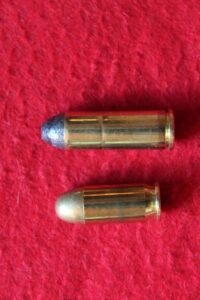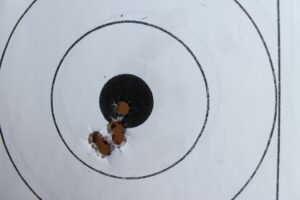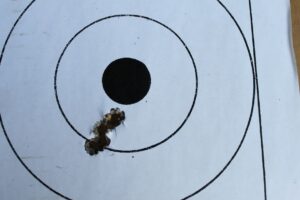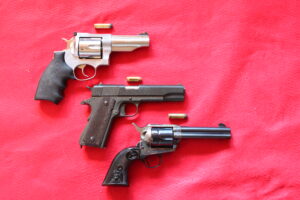
By Jim Dickson | Contributing writer
The two finest all-round handgun cartridges ever conceived, in my opinion, are the .45 Colt and its semi-auto pistol sibling, the .45 ACP.
If you can’t take it out with one shot from either of these two rounds you should be using an elephant rifle because there sure is nothing in North America that both of these cartridges have not put on the ground over the years.
The .45 Colt was a major step up in power for U.S. military pistols when it was introduced. That’s because the Army wanted a pistol that could kill an warrior’s horse at 100 yards or stop a charging cavalry mount.
The original black powder load of 40 grains of black powder in a balloon head case launched a 250-grain bullet at just over 1,000 FPS out of the 7 ½-barrel of the Single Action Army revolver. Today’s smokeless loads launch the same bullet at 850 FPS but it still works just fine on the big stuff.
I have always been completely satisfied with the standard load but for those afflicted with “magnumitis,” they can get a Ruger Redhawk and shoot loads in it that exceed allowable pressures for a vintage revolver. I am referring specifically to CorBon’s 300-grain load at 1,300 FPS and their 350-grain load at 1,050 FPS. Recoil is not bad in the heavy Ruger Redhawk with its rubber grips but the noise decibel level is horrendous with the 1300 FPS just like any of the big magnums. CorBon will warn you that these will blow up a normal pistol so don’t use them in your Colt SAA.
Personally I prefer the Colt SAA with its 4 ¾-inch barrel carried in a duplicate of John Wesley Hardin’s holster made by El Paso Saddlery. It is a natural pointer and very fast to employ if a coyote presents a fleeting target on my farm. The bears are very tolerant of me on my farm and I have been within 10 feet of momma and her cubs while going after my mail and I have also encountered a young black bear on a logging road at 25 yards without incident but I still like a powerful .45 in my hand at these ranges when keeping polite company with my furry neighbors.
American Derringer Corporation makes a lovely .45 Colt double Derringer that makes a splendid back-up pistol for close range work.
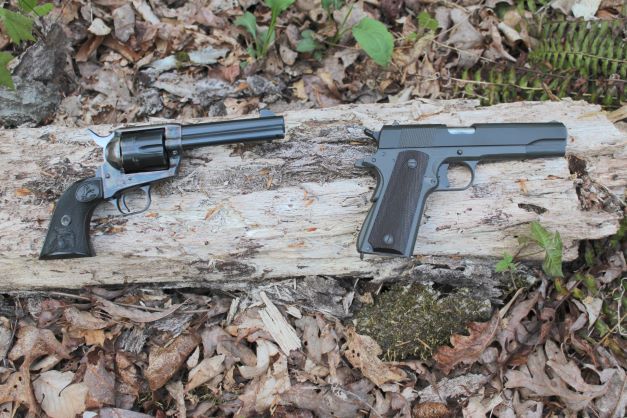
The semiautomatic pistol requires a rimless cartridge so when the Army wanted to transition to a self-loading pistol, the .45 ACP was developed. The Thompson LaGuardia Commission determined that for reliable stopping power, a .45-caliber bullet of 230 to 250 grains at 800 to 900 fps was required so the final version of the .45 ACP had a 230-grain bullet at 850 fps. The .45 ACP was paired with the M1911A1 which is the all-time champion military pistol having unsurpassed reliability and stopping power.
While not as easy to master as the old Colt SAA it is not that hard to master either. My wife, Betty, could shoot every coin you would throw into the air with her M1911A1. If you can shoot a tight group at close range, then you can hit at long range with this pistol. It is no great feat to put your shots in the center of a silhouette target at 200 yards with a good G.I. issue M1911A1. The .45 ACP stabilizes after a certain distance and group sizes do not seem to increase between 250 and 300 yards.
Like the .45 Colt, the .45 ACP is a good hunting cartridge. Either of these rounds are ideal for the subsistence hunter as you can take small game without ruining a lot of meat yet you can still bring down the biggest North American game with either of them. Back when the U.S. Cavalry was wanting to destroy the buffalo herds to starve out the plains Indians, troopers thought it was great sport to ride alongside bison and kill them with their new M1873 Colt single action sidearms. With either of these calibers it is important to use non-expanding bullets on big game. You already have a big enough hole but you don’t want to give up the penetration of the solids on the big stuff.
When Betty and I had Alaskan trapper’s licenses and were living in a one room log trapper’s cabin deep in the Alaskan interior we ended up using WW2-era M1911A1’s with military surplus FMJ ammunition on everything as the ranges in the dense growth of the interior were all well within comfortable pistol range.
There are other reasons that I prefer solids in my .45’s. I have dug enough soft nose and hollowpoint bullets that did not expand out of my backstop to be distrustful of their performance. Also you are giving up a lot of the penetration you need to shoot through any makeshift cover your opponent may take in a gunfight when you are using expanding bullets.
As for accuracy, I find the .45 Colt and the .45 ACP to be equals. Both my pistols and revolvers will shoot less than 2-inch groups at 25 yards and it is a toss-up as to which one will shoot the tightest group on a given day.
As for power, they are essentially equal with standard loads.
For concealed carry the semi-auto has the advantage as it is flatter. Carried in a pancake holster it can be more easily concealed and you can sleep with that gun in its holster if circumstances demand.
The semi-auto has the advantage in firepower as well. Even with HKS Speedloaders, a double action revolver cannot match it and as for the Colt SAA, it is slow to reload, even for someone with plenty of experience.
Despite what some people say, the semi-auto has fewer jams and problems than revolvers. It is far more reliable. I have seen a M1911A1 throw sand out of all its joints when fired and continue to function. Sand in the lock work of a revolver will lock it up as tight.
Both the .45 Colt and the .45 ACP offer a bewildering variety of loads. With the .45 ACP, all loads must be made with the proper recoil impulse to reliably function the action whereas the revolver is limited only by the strength of its cylinder walls. Still, excessively heavy loads will batter the revolver’s internal parts significantly lowering its service life. The Ruger Redhawk is an exception to this as it was designed to take the heaviest loads. It also is stainless steel which helps during the rainy season.
Both the .45 Colt and the .45 ACP can also be used in rifles such as the Rossi 92 lever-action. The .45 ACP can be used in the semi-auto version of the Thompson SMG, the AutoOrdnance M1927.
A big drawback to heavy loads in any pistol is excessive recoil. You can fire several shots with a M1911A1 while a shooter using a revolver is trying to pull his gun down from recoil and get off a second shot.
Because handgun bullets are a poor aerodynamic shape and air resistance goes up exponentially with velocity your average .44 Magnum load has dropped its velocity to less than a .45 Colt or .45 ACP after 50 to 75 yards. Since hydrostatic shock effect does not really start to take place until the velocity is above 2,000 fps, I really don’t see any advantage to magnums. Perhaps the biggest strike against the magnum calibers is the greatly increased decibel level. That gets real serious because you don’t have time to put in ear plugs or don shooter’s earmuffs in an emergency and I don’t see people doing that when hunting either.
If you want a rifle’s performance then carry a rifle. I have seen some super magnum pistols out there that were as bulky and heavy as a rifle even if they were somewhat shorter. They were still too big for practical holster carry or prolonged shooting with one hand.
I have shot about every commercially available load out there but I prefer the standard load with a non-expanding bullet in both .45 Colt and .45 ACP. They have done everything I asked them to do for decades and I have asked a lot of them yet they have never let me down. Just practice enough to shoot accurately and you will find that they are all you ever need in a handgun.

